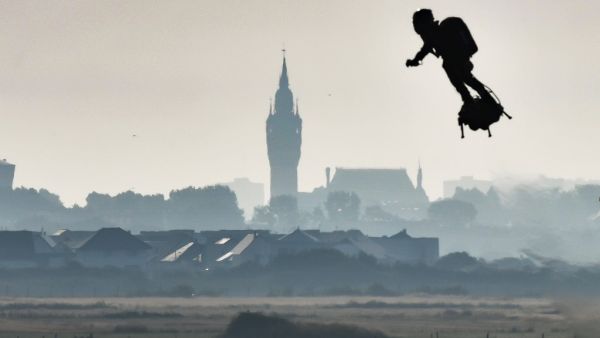Flying Frenchman Franky Zapata today became the first person in history to cross the English Channel on a kerosene-powered board not much bigger than a tea tray – saying it 'feels magnificent!'.
The 40-year-old set off towards the White Cliffs of Dover from Sangatte beach, in Calais, at 7.16am UK time in front of a cheering crowd.
Within seconds he was soaring through the skies looking just like a high-tech version of Marty McFly, the character played by Michael J. Fox in the ‘Back to the Future’ films.
There were shouts of ‘Allez le Flying Frenchman!’ and ‘Go Franky, go!’,including from Mr Zapata’s wife, Kystal.
And at 7.39am – 23 minutes later – the triumphant Mr Zapata landed at St Margaret’s Bay in Kent, saying: 'Frankly, this feels magnificent!'.
The army reservist and former Jetski champion lifted an arm in the air in triumph, shed a tear, and savoured his incredible success.
‘There were no problems this time,’ he told waiting reporters. ‘Frankly, I’m tired – I’m not on holiday, but I’m elated. Thanks so much my team, and to my wife'.
'For the last five to six kilometres I just really enjoyed it. Whether this is a historic event or not, I'm not the one to decide that, time will tell.'
{"preview_thumbnail":"https://cdn.flowplayer.com/6684a05f-6468-4ecd-87d5-a748773282a3/i/v-i-9…","video_id":"9ce42de2-64ac-4375-915c-6e729a467831","player_id":"8ca46225-42a2-4245-9c20-7850ae937431","provider":"flowplayer","video":"North Korea Launches Further Ballistic Missiles Into Sea"}
'We made a machine three years ago...and now we've crossed the Channel, it's crazy,' he said, before breaking into tears.
Ms Zapata had been left hugely disappointed on July 25 when he failed in his first attempt to complete the same 22.4 mile journey.
Then, he had crashed off a refuelling boat 12 miles into the trip, but this time a larger vessel and landing platform were used.
The self-styled ‘Flying Frenchman’ travelled at a speed of some 87mph, staying at least 49 feet above the water.
French naval vessels kept an eye out during the crossing in case of trouble.
Calais authorities also gave him permission to keep the refuelling boat in French waters, something they had refused the first time around due to safety concerns.
Temperatures were above 25C on Sunday, the sun was shinning brightly, and there was next to no wind or waves.
The state-of-the-art device, which was built from scratch, resembled a souped-up tea tray and could reach an altitude of 10,000 feet. It was powered by five turbojet engines.
Mr Zapata wore a flying suit inspired by the lead character in the superhero movie Iron Man.
There was a maximum of 42 litres in Mr Zapata’s backpack, meaning he once again had to refuel half way across the Channel.
This meant landing on a boat, and swapping backpacks during a stop of no more than two minutes.
Before setting off her said he had a ’50 per cent chance of success’ but had ‘absolute confidence in the technology’
He added: ‘We created a new way of flying. We don't use wings. You are like a bird, it is your body that is flying. It is a boyhood dream. We want to follow a little bit in the footsteps of the pioneers of aviation.’
Mr Zapata hopes his device will one day enter commercial production, as a revolutionary piece of military hardware.
Last month, the board impressed crowds at France's annual July 14 Bastille Day Parade, where Mr Zapata zoomed through the air 50ft above Paris's Place de la Concorde dressed as a soldier and brandishing a rifle.
This article has been adapted from its original source.








